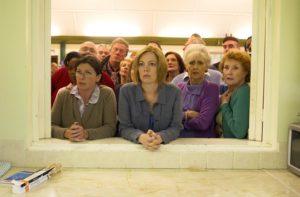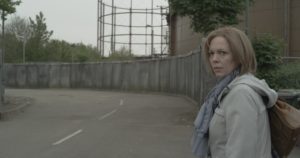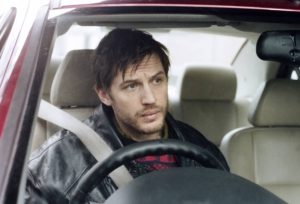
London Road was inspired by the 2006 serial murders of prostitutes in Ipswich, England about 60 miles northeast of London. Originally developed as a play at the National Theatre, writer Alecky Blythe transcribed brief interviews that she had conducted with local residents after the crimes into a narrative form. In collaboration with composer Adam Cork, that narrative was transformed into a verbatim musical. Once the piece started to take shape, Rufus Norris came on board to direct the theatrical production, which opened in 2011.
After having made the award-winning film Broken in 2012, Norris was looking for his next film project, “I felt very passionately that this [London Road], should be that. It is highly unusual. I had never seen a film like London Road, but I thought it would be great to continue the groundbreaking work. It was a completely unique piece of theater. As a director it is very precious to be attached to projects that are unlike anything else.”
Because of differences in the two mediums, adapting a stage play into film can pose challenges. The play opened in a black box theater, then moved to the National Theatre which was “quite Greek” with a thrust stage that made the production presentational compared to the much more realistic nature of film. Nevertheless there were also commonalities that could be transferred from the theatrical experience.
According to Norris, similarities include an “understanding of humanity and rhythm.” Knowing how to allow a story to unfold is not that different in both mediums. What makes a scene active, and the dynamic turning points within a scene are also shared on stage and screen.
“In terms of working with actors there is a natural crossover,” noted Norris. “Even then it is a lot more intimate in the cinema because you can really get inside an actors head with close-ups and different lenses and positions of the camera. Also it is a lot more epic because you can film a whole town, or street, rather than just the size of the stage. On stage you direct the audience where to look through lighting and choreography. In cinema, the camera does a lot of that work for you.”
Norris storyboards, but not in a conventional way. He uses the technique to find the atmosphere. Because the vast majority of his work has been in theater, the director of photography became a major collaborator due to his knowledge of film.
“A normal conversation might be that I wanted to feel like this, so I think we should do this,” explained Norris. “And the DOP will go, ‘Or we could do this.’ Version B that they suggest will generally be a much more sophisticated way of achieving what I want it to feel like. It’s a very close collaboration.”
The fact that the musical was based on verbatim transcripts added another level of complication when translating the story to the screen.

“One of the principle challenges with this piece in the theater, but particularly in film is that 98 percent of the script is verbatim. It’s what people actually said and all of it was said to an interviewer,” shared Norris. “It is not in conversation. There are no scenes as such. Almost every film is made up of scenes where we are a fly on the wall. In this case the fly on the wall is who is being talked to, which is very different.”
The filmmakers had to discover different ways of shooting scenes instead of always having the actors speaking directly to camera. They looked to find a way of getting inside the actors head so that the dialog that they were saying or singing felt like “their voiced thoughts.” To achieve this idea, Norris used close-ups to dramatic effect with the result of conveying the residents’ alternating range of emotions that encompassed threatened, appalled, excited and more.
“We wanted to see the whites of their eyes, to see how paranoid they were. We wanted to see what they were scared of.” Norris continued, “A lot of the close-ups, that language with the camera almost being on the shoulder of protagonists at different times, p.o.v., that kind of stuff, were all elements that I discussed with Danny Cohen, the D.P.”
Many of the crew from the stage production moved across to the film. A number of the sequences incorporated a Busby Berkley kind of staging with precisely choreographed action within a specific location chosen because it provided diverse options for shots from different and unusual camera angles such as wider overhead and steadicam shots going in and out from the intimacy of close-ups; all chosen for emotional effect.
“The production designer, Katrina Lindsay, and choreographer, Javier de Frutos, were very close collaborators. I took the entire creative team with me, which is a really unusual thing to do. We made sure we were supported by people who really understood the medium of film. And the camera crew obviously came from that world,” stated Norris. “It meant that the choreography, which was not taken from the show for the film, was created with those shots in mind. There was a psychology behind the camera applied to the choreography. And it was entirely rooted in the song.”
With the complex music in this film, musical director, David Shrubsole, was invaluable. The music had very complicated time signature patterns and was almost impossible to lip sync to, so all the solo lines were recorded live. Norris credits production sound mixer, John Midgley, for capturing the live singing.
“What that means on set is you have a situation where the sound department are as powerful as the camera department. The camera department was great in accepting that, it just meant that the sound department had as much right to say, ‘No we have to shoot that again and again and again.’ Actually most of the reshoots were for sound, not for camera. That meant the production sound mixer and the musical director were really crucial people in the whole process,” Norris added.
Since he had only made a couple of films, Norris wanted to work with an editor that had a great deal of experience, who was prepared to accept the director’s contributions to the edit, particularly musically. Editor John Wilson was not just experienced, but also a fanatic about verbatim theater.

“That was quite a good marriage,” admitted Norris. “It’s very hard to talk about an edit process. We would discuss something, what the feel of it should be. He would do a bit of work on it and prepare a couple of versions. I would go away. I’m not someone who sits in the edit suite the whole time.”
The musical numbers took the longest time to build. When a film is cut around a story, often temp music is used to create a feel. In the case of London Road, the music was locked before production commenced.
“You already have a very tight skeletal structure that can certainly give you some of the edit points. You can see where the crescendos are, where you want to pull out and where you want to use some of the tighter shots,” said Norris. “It gives you a roadmap.”
Norris made very distinct choices on the grading of the film. The dark, desaturated look – monochromatic except for pops of color – eventually progressed to a bright and vibrant atmosphere. This graduated color palette mirrored the story arc of a metaphorical winter with paranoid individuals fearful of everyone evolving into a flower-filled springtime with a community coming together, rebuilding a positive image for their neighborhood and lives.
The company had around six weeks to shoot a story that takes place over several different seasons. They gambled on when the shoot would occur and because of rain, there was too much green around, so the color-timing also helped to cover the seasonal disparities.
“We took a very, very aggressive set of decisions on the grading and the movement from the beginning were it is kind of 20 percent saturation, to the end where I think we are at about 130 percent. That is really radical,” revealed Norris. “Every single shot we calibrated on that journey.”





